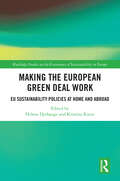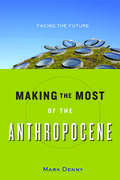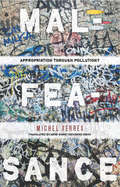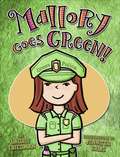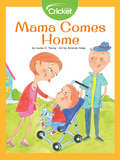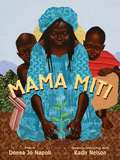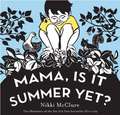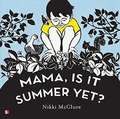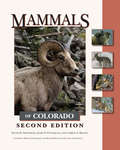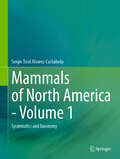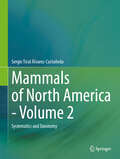- Table View
- List View
Making the European Green Deal Work: EU Sustainability Policies at Home and Abroad (Routledge Studies on the Governance of Sustainability in Europe)
by Helene Dyrhauge and Kristina KurzeThis book critically analyses different dimensions in the sustainable transitions outlined by the European Green Deal, focusing on both internal actions and external relations and highlighting the EU’s diverging powers and capabilities in achieving the core objectives. As with the Green Deal itself, the chapters cover different policies including financial instruments, energy policies, climate policies and external policies and apply the ideal-type logics of appropriateness and consequences to analyse sustainable transformations. The variety of the cases contribute to a broad understanding of how different actors interpret and implement the aims of the European Green Deal, including especially those lagging behind, who, for various reasons, are struggling with the sustainable transition. From examining their policies, the book illuminates the challenges and opportunities they are facing. Overall, the contributions address key questions surrounding the EU’s powers and limits in inducing transformative change and implementing the European Green Deal. This book will be of key interest to scholars, students and practitioners of EU sustainability policies, sustainability transitions and green economy, environmental studies, energy policy, energy governance and climate change, public policy, comparative politics and international relations.
Making the Most of the Anthropocene: Facing the Future
by Mark DennyHumans have changed the Earth so profoundly that we’ve ushered in the first new geologic period since the ice ages. So, what are we going to do about it?Ever since Nobel Prize–winning atmospheric chemist Paul Crutzen coined the term "Anthropocene" to describe our current era—one in which human impact on the environment has pushed Earth into an entirely new geological epoch—arguments for and against the new designation have been raging. Finally, an official working group of scientists was created to determine once and for all whether we humans have tossed one too many plastic bottles out the car window and wrought a change so profound as to be on par with the end of the last ice age. In summer 2016, the answer came back: Yes. In Making the Most of the Anthropocene, scientist Mark Denny tackles this hard truth head-on and considers burning questions: How did we reach our present technological and ecological state? How are we going to cope with our uncertain future? Will we come out of this, or are we doomed as a species? Is there anything we can do about what happens next? This book• explains what the Anthropocene is and why it is important• offers suggestions for minimizing harm instead of fretting about an impending environmental apocalypse • combines easy-to-grasp scientific, technological, economic, and anthropological analyses In Making the Most of the Anthopocene, there are no equations, no graphs, and no impenetrable jargon. Instead, you'll find a fascinating cast of characters, including journalists from outer space, peppered moths, and unjustly maligned Polynesians. In his bright, lively voice, Denny envisions a future that balances reaction and reason, one in which humanity emerges bloody but unbowed—and in which those of us who are prepared can make the most of the Anthropocene.
Malfeasance: Appropriation Through Pollution?
by Michel Serres Anne-Marie Feenberg-DibonIn this highly original and provocative book, Michel Serres reflects on the relation between nature and culture and analyzes the origins of the world's contemporary environmental problems. <P><P>He does so through the surprising proposition that our cleanliness is our dirt. <P>While all living beings pollute to lay claim to their habitat, humans have multiplied pollution's effects catastrophically since the Industrial Revolution through the economic system's mode of appropriation and its emphasis on mindless growth. He warns that while we can measure what he calls "hard pollution"--the poisoning of the Earth--we ignore at our peril the disastrous impact of the "soft pollution" created by sound and images on our psyches. <P>Sounding the alarm that the planet is heading for disaster, Serres proposes that humanity should stop trying to "own" the world and become "renters." Building on his earlier work, especially that on hominization, he urges us to establish a "natural contract" with nature.
Mallory Goes Green (Mallory, Book #13)
by Laurie FriedmanMALLORY McDONALD IS GOING GREEN! As an official member of the Fern Falls Elementary Environmental Committee, Mallory is super excited to make her school and home more environmentally friendly. She's even selected to be class representative for the all-school Green Fair. But the minute Mallory goes green, everything goes wrong. No one wants her "expert" opinion on how to help the environment. Her classmates don't want to participate in the Green Fair project she's created. And worst of all, by the time the fair rolls around, many of them aren't even speaking to Mallory. Can Mallory find a way to save the planet and her friendships?
Mama Comes Home
by Louise O. YoungOn a trip in the stroller, a little boy sees animals, cars, and his mama.
Mama Miti: Wangara Maatha and the Trees of Kenya
by Donna Jo NapoliOne woman. One seed. One hope for the future. Thayu nyumba--Peace, my people. Wangari grew up in the shadow of Mount Kenya listening to the stories about the people and the land around her. Though the trees towered over her, she had loved them for as long as she could remember. So strong, so beautiful, how the trees made her smile. Wangari planted trees one by one to refresh her spirit. When the women came to her for help with their families, she told them to do the same. Soon the countryside was filled with trees. Kenya was strong once more. Wangari had changed her country, tree by tree. Donna Jo Napoli tells a story inspired by the life of 2004 Nobel Peace Prize recipient Wangari Maathai that will touch the hearts and spirits of all who read it. Kadir Nelson's stunning collage illustrations honor the spirit of a land and of the woman who saved it. In honor of the publication of this book, the publisher has made a donation to the Green Belt Movement to plant trees in Kenya. For more information on the Green Belt Movement, visit greenbeltmovement.org.
Mama, Is It Summer Yet?
by Nikki McClureAs spring slowly turns to summer, a little boy builds a fort and plant a garden in impatient anticipation in this book.
Mammals of Colorado, Second Edition
by David M. Armstrong James P. Fitzgerald Carron A. MeaneyThoroughly revised and updated, Mammals of Colorado, Second Edition is a comprehensive reference on the nine orders and 128 species of Colorado's recent native fauna, detailing each species' description, habitat, distribution, population ecology, diet and foraging, predators and parasites, behavior, reproduction and development, and population status. An introductory chapter on Colorado's environments, a discussion of the development of the fauna over geologic time, and a brief history of human knowledge of Coloradan mammals provide ecological and evolutionary context. The most recent records of the state's diverse species, rich illustrations (including detailed maps, skull drawings, and photographs), and an extensive bibliography make this book a must-have reference. Amateur and professional naturalists, students, vertebrate biologists, and ecologists as well as those involved in conservation and wildlife management in Colorado will find value in this comprehensive volume. Co-published with the Denver Museum of Nature & Science
Mammals of North America - Volume 1: Systematics and Taxonomy
by Sergio Ticul Álvarez-CastañedaThe book synthesizes nomenclature, systematics, and descriptions of North American mammal species. Clear, simple and illustrated identification keys are provided to make knowledge of mammals easier and facilitate the training both students and professionals in the field, including readers without extensive experience. Descriptions of the different species are provided up to Order, highlighting the diagnostic features that allow identifying them promptly while the reader learns how to make subsequent identifications without having the book at hand. Each species comes with potential distribution maps based on existing records in the main museums of North America. The book includes the description, characteristics and distribution maps of the 781 species with range in the North America subcontinent
Mammals of North America - Volume 2: Systematics and Taxonomy
by Sergio Ticul Álvarez-CastañedaThe second volume of this book series synthesizes nomenclature, systematics, and descriptions of North American mammal species. Clear, simple and illustrated identification keys are provided to make knowledge of mammals easier and facilitate the training both students and professionals in the field, including readers without extensive experience. Descriptions of the different species are provided up to Order, highlighting the diagnostic features that allow identifying them promptly while the reader learns how to make subsequent identifications without having the book at hand. Each species comes with potential distribution maps based on existing records in the main museums of North America. The book includes the description, characteristics and distribution maps of the 781 species with range in the North America subcontinent
Mammals of North America: Second Edition (Princeton Field Guides #58)
by Roland W. Kays Don E. WilsonThe best field guide to North American mammalsThe best-selling field guide that "sets new standards" (New Scientist) and "makes all other field guides for mammals of the United States. . . and Canada obsolete" (Journal of Mammalogy) is now even better. Covering 20 species recognized since 2002 and including 13 new color plates, this fully revised edition of Mammals of North America illustrates all 462 known mammal species in the United States and Canada—each in beautiful color and accurate detail. With a more up-to-date species list than any other guide, improved facing-page descriptions, easier-to-read distribution maps, updated common and scientific names, and track and scat illustrations, this slim, light, and easy-to-use volume is the must-have source for identifying North American mammals.Roland Kays and Don Wilson have scoured the technical literature to pull out the key differences between similar species, and illustrated these whenever possible, making the guide useful to amateur naturalists and professional zoologists alike. Casual animal watchers will appreciate the overview of mammal diversity and the tips on identifying animals they can spy in their binoculars, while scientists will appreciate the exacting detail needed to distinguish similar species, including illustrations of shrew teeth, bat toes, and whale dorsal fins.The best-illustrated and easiest-to-use field guide to North American mammalsBeautiful and accurate color illustrations of all 462 mammals found in the United States and Canada—including 20 species recognized since 2002112 color plates—including 13 new onesKey identification information—fully revised—on facing pagesThe most current taxonomy/species listFully revised, easy-to-read range mapsIllustrations of tracks, scat, and whale and dolphin dive sequences
Mammals of the Great Lakes Region, 3rd Ed.
by Allen KurtaNow in an extensively revised 3rd edition, Mammals of the Great Lakes Region has been an essential reference for countless amateur and professional naturalists since 1957. Easily tucked into a backpack and carried into the field, this heavily illustrated guidebook offers detailed information on 83 species, including each mammal’s appearance, behavior, and natural history, along with an explanation of its scientific name. Species accounts are accompanied by new color photographs plus fully updated distribution maps showing the geographic range in the Great Lakes region and in North America. A thorough introduction outlines the environmental factors that affect the distribution and abundance of mammals in Great Lakes ecosystems and discusses the impacts of current human activities, including introduction of diseases and climate change. There is also a section on preparing captured specimens for research or teaching, as well as user-friendly keys and quick reference tables to physical measurements and life history data. Brand new in this edition, the book also features detailed illustrations of the tracks of commonly found mammals to assist with year-round identification. Providing the most up-to-date information on mammals in the Great Lakes basin, this book belongs on the shelves of teachers, students, naturalists, and professional biologists throughout the region.
Mammals of the Rocky Mountains
by Chris Fisher Don Pattie Tamara HartsonThis fascinating and readable textbook describes these mammals in detail-what they look like, what they eat, where they live, what they like to do. Since otters intrigue me, here's a sample from the pages about them. Northern River Otter Lontra canadensis It may seem to be too good to be true, but all those playful characterizations of the Northern River Otter are founded on truth. Otters often amuse themselves by rolling about, sliding, diving or "body surfing," and they may also push and balance floating sticks with their noses or drop and retrieve pebbles for minutes at a time. They seem particularly interested in playing on slippery surfaces-they leap onto the snow or mud with their forelegs folded close to their bodies for a streamlined toboggan ride. Unlike most members of the weasel family, river otters are social animals, and they will frolic together in the water and take turns sliding down banks. With their streamlined bodies, rudder-like tails, webbed toes and valved ears and nostrils, river otters are well adapted for aquatic habitats. Even when they emerge from the water to clamber over rocks, there is a serpentine appearance to their progression. The large amounts of playtime they seem to have results from their efficiency at catching prey when it is plentiful. Although otters generally cruise along slowly in the water by paddling with all four feet, they can sprint after prey with the ease of a seal whenever hunger strikes. When an otter swims quickly, it chiefly propels itself with vertical undulations of its body, hindlegs and tail. Otters can hold their breath for as long as five minutes, and, if so inclined, they could swim the breadth of a small lake without surfacing. ... In the past, the Northern River Otter's thick, beautiful, durable fur led to excessive hunting. This file should make an excellent embossed braille copy.
Mammoth Cave
by Horton H. Hobbs III Rickard A. Olson Elizabeth G. Winkler David C. CulverThis book reveals the science and beauty of Mammoth Cave, the world's longest cave, which has played an important role in the natural sciences. It offers a comprehensive and interdisciplinary treatment of the cave, combining insights from leading experts in fields ranging from archeology and cultural history to life science and geosciences. The first animals specialized for cave life in North America, including beetles, spiders, crayfish, and fish, were discovered in Mammoth Cave in the 1840s. It has also been used and explored by humans, including Native Americans, who mined its sulfate minerals and later African-American slaves, who made a map of the cave. More recent stories include 'wars' between commercial cave owners, epic exploration trips by modern cave explorers, and of course tourism. The first section of the book is an extensive description including maps and photos of the cave, its basic structural pattern, and how it relates to the surface landscape. The second section covers the human history of utilization and exploration of the cave, including mining, tourism, and medical experiments. Cave science is the topic of the third section, including geology, hydrology, mineralogy, climatology, paleontology, ecology, biodiversity, and microbiology. The fourth section looks to the future, with an overview of environmental issues facing Mammoth Cave managers. The book is intended for anyone interested in caves in general and Mammoth Cave in particular, experts in one discipline seeking information about other areas, and researchers and students interested in the many avenues of pursuit possible in Mammoth Cave.
Mammoth Cave National Park: Reflections
by Raymond KlassGo deeper into this national treasure with “a sumptuous collection of photographs [that] captures the wonderment and majesty of the cave system” (Louisville Courier-Journal).Kentucky’s Mammoth Cave National Park is home to the world's longest cave system, boasting over 350 miles of explored and mapped passageways—and geologists estimate that there could be many more miles of this vast subterranean world that remain unexplored. In addition to the renowned Mammoth Cave, the park also includes over 50,000 acres of hills, streams, and forests with nearly seventy miles of scenic trails.The Green River, which plays an integral role in the cave’s ecosystem, winds through this impressive landscape. As an artist-in-residence at the park, nature photographer Raymond Klass was granted access to the cave and the surrounding wilderness. While living at the park, he took thousands of photographs of famous cave formations, such as Frozen Niagara and the Drapery Room, as well as scenery and wildlife not often seen by the general public. Mammoth Cave National Park: Reflections is a record of Klass’s unique visual exploration of the above- and belowground ecosystems within the park.With more than 100 dramatic full-color photographs, accompanied by Klass’s commentary and extracts from the journal he kept while living and working in the park, this book captures the sights and surprises of the vast underground world of the cave system—its labyrinths and mineral formations, remnants of human visitors and gypsum miners, streams and rivers hundreds of feet below the surface, and more.“The detail in the photographs lets the reader absorb the wonder of Mammoth Cave perhaps more than a simple day trip to the park could ever provide.” —Kentucky Living
Mammoth Cave and the Kentucky Cave Region
by Bob Thompson Judi ThompsonMammoth Cave National Park and the surrounding area comprise the world's most extensive cave system. The region is characterized by what geologists call "karst" topography, a landscape dotted with sinkholes and caves. One of America's first tourist attractions, the cave was opened to the public in 1816, and was preceded in popularity only by Niagara Falls. The 200 vintage images found in Images of America: Mammoth Cave and the Kentucky Cave Region represent a look back at over 100 years of photography and tourism at Mammoth Cave and other caves that make up the Kentucky Cave Region. Rare images of early transportation, hotels, cave guides, cave tours, as well as important cave discoveries, and cave explorers such as Floyd Collins are shown throughout the book.
Mammoth Stampede: Book 4 (Xtinct! #4)
by Ash StoneA giant woolly mammoth comes back to life in this action-packed adventure story.Time is running out! Barron Fox's hunting lodge is opening soon, and Jeevan discovers that he's planning a very big surprise for his guests - a woolly mammoth, brought back to life for them to hunt!If the lodge opens, the animals in the forest will be in danger too. Can Jeevan and his friends launch a daring rescue mission that tramples over Fox's plans?Perfect for fans of Beast Quest, Deadly 60 and Jurassic Park, these action-packed adventures will inspire readers to help save endangered species and combat extinction.
Mammoths and the Environment
by Valentina V. UkraintsevaThe study of fossilised remains of herbivorous animals, particularly those rare findings with well-preserved gastrointestinal tracts filled with plant remains, is crucial to our understanding of the environment in which they lived. Summarising thirty years of research, Ukraintseva presents evidence on plants once eaten by Siberia's major herbivorous mammals. The collection of pollen and plant spores from food remains sheds light on the vegetation of these ancient habitats, enabling researchers to reconstruct local floras of the time. This also promotes further insight into the causes of the extinction of various species due to changing environmental conditions and food availability. Providing a history of the research undertaken, the book also includes specific chapters on the Cherski horse and bison, along with the vegetation and climate of Siberia in the late Anthropogene period, making it a lasting reference tool for graduate students and researchers in the field.
Man And Environmental Processes: A Physical Geography Perspective (Studies In Physical Geography)
by K. J. GregoryThe aim of the present volume is to review the effects of human activity on physical environment processes, and this is justified not only as a complement to the approach taken by G. P. Marsh his volume Man and Nature (1864), but also as a sequel to the work produced since 1864, with contributions since the mid-nineteenth century to the study of th
Man Who Saved Books
by Lynn PlourdeOne town&’s trashbecomes the dump man&’s treasure in this inspiring tale by award-winning author Lynn Plourde. Mr. Pottle, who oversees the town landfill, just cannot bear to see books thrown out and destroyed, so he rescues and recycles them for the community to enjoy. When Mr. Pottle takes a fall one day and is injured, that community—especially the children—comes to his rescue. The townspeople bring books to speed his recovery—and are amazed to discover that the book-loving man cannot read. That&’s when a town full of eager readers helps Mr. Pottle to fully enjoy his treasures.Illustrations by Mary Beth Owens are packed with details that capture the chaos and beauty of a dump and show Mr. Pottle&’s determination to let nothing of value to go to waste. Little ones will love the way favorite items keep showing up in different places around the dump.An enjoyable picture book in its own right, The Man Who Saved Books also delivers a heartwarming message about the treasures to be found in books, in reading together, and in friendship.
Man and Animal in Severan Rome
by Steven D. SmithThe Roman sophist Claudius Aelianus, born in Praeneste in the late second century CE, spent his career cultivating a Greek literary persona. Aelian was a highly regarded writer during his own lifetime, and his literary compilations would be influential for a thousand years and more in the Roman world. This book argues that the De natura animalium, a miscellaneous treasury of animal lore and Aelian's greatest work, is a sophisticated literary critique of Severan Rome. Aelian's fascination with animals reflects the cultural issues of his day: philosophy, religion, the exoticism of Egypt and India, sex, gender, and imperial politics. This study also considers how Aelian's interests in the De natura animalium are echoed in his other works, the Rustic Letters and the Varia Historia. Himself a prominent figure of mainstream Roman Hellenism, Aelian refined his literary aesthetic to produce a reading of nature that is both moral and provocative.
Man and Wildlife (Routledge Library Editions: Conservation #4)
by L. Harrison MatthewsOriginally published in 1975, Man and Wildlife traces the evolution of man from pre-hominid ancestors, and his influence in modifying the environment and its flora and fauna as technical knowledge grew. The development of civilization allowed man to dominate the environment; its advance led to the discovery and exploitation of the world’s resources. In spite of all the discoveries of science, man’s battle with the adverse forces of wildlife remain un-won and seems likely to stay so for the foreseeable future. The book traces the beginnings of environmental consciousness in the decades preceding its publication. It examines the extent of the human devastation of the environment, which has increased with rapid expansion of the world’s human population, and the belated efforts to halt the destruction and help wildlife preservation.
Man and the Natural World: Changing Attitudes in England 1500-1800
by Sir Keith Thomas'Man and the Natural World, an encyclopaedic study of man's relationship to animals and plants, is completely engrossing ... It explains everything - why we eat what we do, why we plant this and not that, why we keep pets, why we like some animals and not others, why we kill the things we kill and love the things we love ... It is often a funny book and one to read again and again' Paul Theroux, Sunday Times 'The English historian Keith Thomas has revealed modes of thought and ways of life deeply strange to us' Hilary Mantel, New York Review of Books'A treasury of unusual historical anecdote ... a delight to read and a pleasure to own' Auberon Waugh, Sunday Telegraph'A dense and rich work ... the return to the grass roots of our own environmental convictions is made by the most enchantingly minor paths' Ronald Blythe, Guardian
